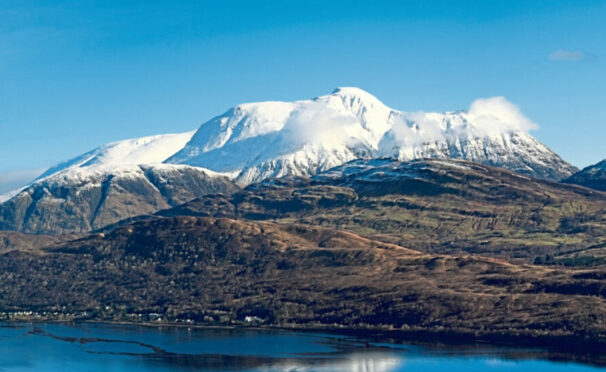
It may be the second-highest mountain in Fort William’s Nevis Range – only Ben Nevis is higher – but Aonach Beag is quite a secretive hill.
At 1,234m (4,049ft), it’s the UK’s seventh-highest peak, but it’s hard to spot, often obscured in roadside views by its near neighbour, Aonach Mor at 1,221m (4,006ft). The two Munros are connected by a narrow bealach and are usually climbed as a pair, generally referred to as “the Aonachs”.
The best view of the duo is from the Grey Corries, the hills lying immediately to the east and linked to a subsidiary summit of Aonach Beag, Stob Coire Bhealaich, by a col with a low point of 731m (2,398ft).
Aonach Mor is the home of the Nevis Range ski centre, so any approach from the north is among the tows and runs, which detract from any feeling of “wildness”.
Far better is to approach via Polldubh. It takes in gorgeous little Glen Nevis – Scotland’s own miniature version of a Himalayan valley!
The ascent from here, once on the hill, is pathless and – although unremittingly steep in sections – gives a sense of remoteness and solitude. As well as being the taller of the two Munros, Aonach Beag is also the finer – Aonach Mor has a much broader summit plateau, so views tend to lack depth.
On ascent of Aonach Beag however, the views of Ben Nevis’s north-east face and the Carn Mor Dearg arête in particular appear increasingly impressive – as do those east to the Grey Corries.
The high eastern cliffs of both Aonach Munros hold snow long into summer – patches tend to survive year-round most years – and they’re popular winter climbing venues, particularly since the opening of the ski centre, the lifts making access easier. The eastern edges of the two Munros can cornice heavily in winter and great care is needed. The cliffs also mean a good level of navigation skills are required in poor visibility – especially at the narrow bealach and on the considerable, featureless plateau of Aonach Mor.
Neighbouring Munro Aonach Mor is a popular venue for skiers. The sport has been enjoyed on the hill since the 1930s but it was only in 1989 that the centre now known as the Nevis Range – with its formal pistes and gondola – was opened.
The centre has continued to develop over the years and in summer is an incredibly popular – and successful – venue for mountain-bike riders.
It’s regarded as one of the best mountain-bike courses in the world and has hosted the Fort William UCI World Cup 17 times between 2002 and 2018 as well as the Mountain Bike World Championships in 2007.
The gondola can be used by hillwalkers to access the hillside high on Aonach Mor, from where an easy ascent of Aonach Beag can also be made. However, such an ascent could only be regarded as cheating by any self-respecting Munro-bagger.
Guide
Pronunciation: E-noch Beg
Meaning: little ridge
Height: 1,234m (4,049ft);
Rank: 7
OS Landranger Map 41
Summit grid ref: NN196715 (cairn)
Nearest town: Fort William is about 10km (6.2 miles) north-west. Scotland’s “outdoor capital” is well served by public transport. It has supermarkets, gear shops and lots of food, drink and accommodation options. Lochaber Geopark visitor centre, in the town centre, makes for a great visit when the weather’s poor.
The route
Start grid ref: NN167691
Distance: 16km (9.9 miles)
Ascent: 1,480m (4,856ft)
Time: 7hrs
The most scenic route to Aonach Beag begins at Polldubh, at the end of the public road in Glen Nevis. From there, head along Nevis Gorge – it’s a rocky path with some big drops. The path exits the gorge to a wide, flat grassy meadow.
Follow the north bank of the Water of Nevis, crossing a bridge to the ruins of Steall Cottage. A direct ascent north, along the Allt Coire Guibhsachan, can be made but we’ll save this path for the descent. A slightly longer but far more attractive route is to head north-east from the ruins. Your target is the ridge that leads to Sgurr a’ Bhuic.
The grassy slopes are a bit of a slog. They flatten at about 800m (2,625ft) before the final pull east to the summit. From there, follow the rim of the crags north-east to a bealach and then ascend to Stob Coire Bhealaich, before the final pull up to the Munro Aonach Beag. Stony slopes north-west take you in a steep descent to the tiny bealach. From there, easier ground ascends in a little over 1km (0.6 miles) to the summit of Aonach Mor at 1,221m (4,006ft). The route of return is tough in poor visibility. Retrace your steps but bear right before the bealach – there’s a bit of a path. You want to reach point NN192722 – from there, head west down very steep ground to the bealach with Carn Mor Dearg. Then it’s south into Coire Giubhsachan, back to Steall Cottage and along Nevis Gorge.

Enjoy the convenience of having The Sunday Post delivered as a digital ePaper straight to your smartphone, tablet or computer.
Subscribe for only £5.49 a month and enjoy all the benefits of the printed paper as a digital replica.
Subscribe